Manning, Assange, Snowden….but before the age of Wikileaks came brilliant electronics, communications and surveillance expert and whistleblower William Francis Roy who was killed at the Australian National University, Canberra, Australia in March 1991.
With Edward Snowden's plight as a whistleblower in the news, William Roy should be remembered as perhaps the only other insider known to have attempted to expose U.S. government surveillance of citizens of Australia and many other countries, seeking planetary domination through force, violence and spying in a grave violation of civil and political rights. Edward Snowden will hopefully live, but William Roy knew without a doubt that he would die, yet such was his bravery in the shadow of the world's most powerful and possibly most malevolent government that he would not back down or leave the country.
William Francis Roy was born in Wollongong, N.S.W. His father and grandfather were coalminers and he grew up believing strongly in the union movement. A lifesaver at South Beach, he was a marathon runner and became a soccer coach and referee.
When he first left school he studied radio servicing at Wollongong Technical College. He joined the RAAF to learn about the still new technology of radar. At nineteen he became the youngest inspector of aircraft electrical systems. He showed very early promise in electronics, completing further studies and constantly learning. Stationed in Darwin with the RAAF, he refused to salute officers, informing them when challenged that all men are equal. Some wanted him court-martialled, but he was so valued that he was indispensable. Darwin remains a non-saluting base to this day.
He left the RAAF and was employed by the G.P.O., working on telephone exchanges, Posts and Telegraphs in the outback. He then obtained a position as technical officer at 2KP Radio Station at Smithtown, going on to become Chief Technical Officer at several country ABC radio and television stations. He soon became known as a brilliant troubleshooter and was called in when all else failed and some problem couldn’t be fixed, travelling far and wide at times. He continued his studies in electronics at night.
Bill joined the Communist Party around this time. For years he was followed by ASIO agents and his record can be found on the National Archives website using a name search.
One report notes, “Subject is employed as an engineer in the Internal Plant Radio Broadcasts Stations Division Engineering Services. He is employed at key points and has access to vital equipment.” “Character and Security Check: William Francis Roy, employed as a technician. Roy is on record in this service as a suspected member of the Communist Party and is the holder of five non-dividend paying shares in the Communist Party People’s Printing and Publishing Society. There is a security objection to employment of Mr Roy by the Commonwealth.” The People’s Printing and Publishing Society was considered a huge threat to the government, by then gravitating away from Britain and towards a close alliance with the United States which was cemented by the joint ventures into Korea and Vietnam. It was the Wikileaks of those times.
In another report by ASIO it is stated: “Advice has been received that William Francis Roy is considered a definite security risk and that consideration should be given to transferring him to work which is not of a ‘key point’ nature, particularly in any national emergency’.
“Subject’s car UX 293 was seen outside the residence of Richard Odes, who is recorded as Secretary of the Fairfield Branch of the Communist Party of Australia and whose residence is believed to be used as a printing establishment of the CPA.” Again, the equivalent of Wikileaks headquarters today. Information about government corruption, cover-ups and lies could only be disseminated in those days via print.
The ASIO files show that Bill was followed for years by agents. He became a friend of the late Professor Robin Allenby Gollan, fellow communist, also from Wollongong. Professor Gollan died in Canberra in 2007 and is also the subject of copious volumes of ASIO files.
Bill quickly realized that while the government needed his superior electronics knowledge and skills, his career was going nowhere while he remained a member of the Communist Party. After several internal inquiries similar to court martials at which he nearly lost his position with the government, he decided to leave the Communist Party and join the Australian Labor Party as a tactical move.
He did so with apparent great enthusiasm, becoming President of the local branch in whichever town he happened to be living. The security objection was withdrawn and he was free to pursue his career. But in his heart he was still a communist and throughout the following years, ASIO, probably suspecting this, paid regular visits to his home for purposes of interrogation.
Throughout his life, Bill remained committed to the principles of freedom of information, honesty and openness in government, a free society with no division or alienation. He believed in a world where people and nature came before profits, where all people were equal – men, women, black and white. On one occasion when travelling through a country town, he stopped to eat lunch in a park. Also in the park was a well dressed Aboriginal man wearing a suit and tie, but no shoes. Bill approached him, shook his hand and inquired where he was going. He said he was going to a job interview and apologized for his lack of shoes. Bill took off his shoes and socks and gave them to him, wishing him luck.
Bill was against all war and led demonstrations against the Vietnam War, taking the podium at the famous “Keep Ky Out” demonstration attended by tens of thousands of people in Sydney.
He was an atheist from an early age. Holding such high ideals, it is obvious that in time there would be conflict between his own principles and the increasingly secretive, malevolent and disturbing requirements of his job with the Commonwealth Government. Democracy and openness were being undermined before his eyes and even with his collaboration.
It was Bill who took charge of the installation of Broken Hill’s first television station, taking his family to live there for a year while the project was completed. He was known as a fair supervisor who expected high standards of those working with him. He treated all employees as equals, eating lunch with them, insisting on being called Bill and challenging the younger ones to long-distance runs and bicycle rides, which he always won.
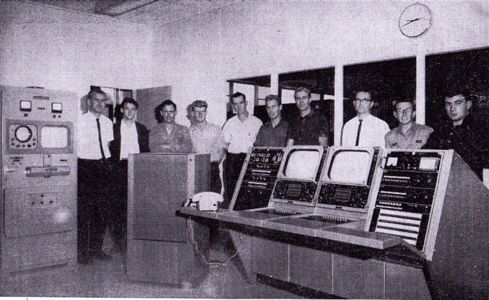
Picture: Bill Roy, third from right
Bill Roy was promoted to the position of Principal Technical Officer at Telecom in Canberra. It was to be his job to oversee the installation of all technical equipment in the soon to be built Telecom Tower. He was Australia’s most talented electronics expert. Every piece of electrical and electronic equipment you see in Black Mountain Tower was either installed by Bill or by someone under his direction. He was also in charge of maintenance at Tidbinbilla Tracking Station and the Australian Broadcasting Corporation radio and television transmitters in Canberra. He played such a vital role during these years in communications during manned space flights that astronauts often visited Canberra to thank him in person. He was able to speak with the astronauts in space and had a direct line to the White House. He was given a Commonwealth car with the first-ever ‘car phone’, the forerunner of the mobile phone we know today.
At early photo of Bill Roy with ABC transmitter equipment
With astronauts Crippen and Young at Telstra Tower, Canberra. Photo: Canberra Times
The new Telecom Tower, situated on Black Mountain, Canberra, was not built so that Canberra residents could have better TV reception. It is a base for espionage, jointly run by ASIO and the CIA. It was part of Bill’s job to interview and hire translators of Russian, German and other languages after they had been approved by ASIO.
Picture: U.S. spy base Telstra Tower
The behaviour of Bill’s employer was at odds with his core beliefs in honesty and open government. He disliked the intrusion of the CIA into Canberra, the political heart of Australia. Now, instead of being followed by ASIO as a suspected spy and conspirator, he was working for them. He himself had become one of their instruments of oppression. He was in a position of trust and power. On the one hand he felt an obligation not to betray his employers, on the other the methods being employed by the CIA in spying on Australian citizens as well as supposedly ‘friendly’ foreign embassies were troubling his conscience. He knew about Echelon, the spy network that provides access to unbelievable amounts of information; and, as a consequence of that information - provides a select group of people and the power elite who back them the potential power to manipulate people, events and economic outcomes in a covert way the world over.
Echelon collects information through an extensive system of radio antennae and satellites that monitor satellite communications and sniffer devices that collect Internet communications from data packets. Some sources claim that the organization employs underwater devices to tap into transcontinental fiber optic phone cables.
By the late 1980s he had had enough and was determined to become a whistleblower.
Picture: Telecom Tower employees with, second from left, astronaut Robert Crippen, then Bill Roy and astronaut John Young, other technicians employed at the Tower.
The internet was five years away from becoming a viable means of exposing government misdeeds and betrayal. He started to plan how to go about exposing the things he had witnessed, been involved in and assisted to carry out. He began to talk to family and friends, hinting at the shocking extent of surveillance by the United States. He made it clear he planned to go public. He said, “The whole world is going to be shocked when they find out what the United States has been doing.” But the whole world wouldn’t find out until 2013.
He knew he was being watched and listened to. The Minister for Communications phoned him and threatened him, warning him to stop contacting the media. There were other phone calls. He told family members he may be killed.
A translator of German and Russian was needed at Telecom Tower. Bill interviewed a woman, Ruth Zsebehazy nee Ruth Maria Martha Ludigkeit (now deceased) for the position. She had been cleared by the Australian Secret Intelligence Service to work at Telecom Tower. A former neighbour would later reveal it wouldn't be the first time she had worked for ASIO. She had a history of employment in the area of espionage but this had been years previously. She failed the written English test and Bill decided not to employ her. She broke down in tears, claiming to be a poor widow in need of a job. Later it turned out she owned property in several cities and was very wealthy, her husband having died in suspicious circumstances some years previously, according to the neighbour who was interviewed later.
The Russian Interpreter: There's no substitute for old-fashioned fieldcraft, so they say, in the world of espionage. This very strange letter to Ruth Zsebehazy was intercepted in September 1991. It reads:
"as I not heard from you for some time,so what is going on.
Please write to me and inform me of everything.
All the best from me.
Canberra 15/9/ 91
a good and trusting friend."
She said she could clean. Bill felt sorry for her and employed her as a cleaner. She hardly ever showed up for work, claiming to have asthma, but she lured Bill away from his family. She had certain photos which she threatened to send to various people. In fact, she sent the first in the series to his parents. It was very sordid and he moved into her house following a late-night phone call to the family home in which he was threatened with exposure by Zsebehazy. Without any explanation to his wife, he left, and was collected from the road outside in a car a few minutes later. Zsebehazy did not drive. It became clear much later that ASIO itself wanted Zsebehazy in the Tower, not so much to work as a translator as she had done in the past, but to have access to William Roy, who was proving a troublesome employee. Now she had got him out of the safe haven of the family home and into her house, where she could watch him, report on his activities and where she would attempt to poison him. Blackmail by means of photos was used to keep him there, and to get him back on the two occasions that he attempted to leave. She never went back to work as a cleaner at the Tower after that night. Her objective had been achieved.
Meanwhile Bill was interviewed by Jana Wendt, who then worked for ABC TV. It is believed during this interview he gave information about the equipment housed in Telecom Tower and the actions of both the United States and Australian governments in spying on its citizens and various embassies, which are supposedly protected by international covenants from this kind of intrusion. The full extent of the information Bill was seeking to expose is not known. A search of his papers after death gave no hint and his computer was not given to his family. Everything he owned was now in the hands of former spy Ruth Zsebehazy, ie, the enemy.
Whether this extensive interview with Jana Wendt went to air is not known, but a short segment taken from it was shown on the 7.30 Report in August 1995 in relation to the activities of the CIA in Australia with Bill speaking briefly about the kinds of equipment housed in the Tower. By this time, the truth was out regarding the Chinese Embassy and the ‘spy scandal’ had broken in the media. It was only the tip of the iceberg, as has now been revealed by Edward Snowden. It was the mass surveillance programmes that Bill was most concerned about and that he was involved in implementing.
VideoYouTube: Some footage of William Roy speaking about Telstra Tower. NB: A D-notice was placed on this 7.30 report the night it was aired. The Australian Government will take steps to force YouTube to take it down. Watch it while you can.
http://www.youtube.com/watch?v=5rO8D5oxrq0
The family member investigating Bill's death requested the Jana Wendt interview tape from the ABC. They were told they could not have it due to a D-notice.
In 1990, it was learned that ASIS, with assistance from 30 NSA technicians, had bugged the Chinese Embassy in Canberra. The story had originally been picked up by an Australian newspaper but ASIS asked them to sit on it. Shortly thereafter, Associated Press also picked up the story and ASIS also asked them to abide by a D-Notice. But somehow, the story made its way to Time magazine, where it was published, compromising the operation. It is believed Bill Roy was the whistleblower in this case.
The First Attempt
Bill remained a keen rider of a racing bicycle. He was out riding in August 1990 when some kind of incident occurred. The full circumstances of this incident are not known, but the remains of that bicycle were obtained through the Coroner’s office and given to a family member. The wheel of the bicycle was badly damaged. Bill told family members around this time that he expected to be killed and mentioned the contents of his will. He also complained that Ruth Zsebehazy was becoming violent and insisting that he ate a certain cake that she would cook for him. He did not like cake. He was both lecturing and studying at the National University which required him to be out late on his bicycle, which he used as transport.
Picture: The green Peugeot bicycle. It appears that a heavy object was thrown at the wheel, smashing the hub and spokes.
The Poisoning
By late 1991 Bill had left Telecom Tower. An incredibly fit man, still running marathon distances, he was admitted to Royal Canberra Hospital in November 1991 suffering from "nephrotic syndrome" - a condition described in forensic medicine texts as highly suspicious and often caused by toxic substances. . (Reference: "Forensic Medicine for Lawyers"). His organs failed and he was close to death. Results of a biopsy which was done at the time clearly showed a foreign substance with a flocculent appearance was present in the kidneys. For reasons that are not explained, no toxicological tests were done; perhaps the results were destroyed. Specialists wrote on his notes they were completely at a loss as to why his kidneys had failed.
The biopsy reports were obtained two years after Bill’s death following a legal fight with the Coroner’s Office. Family members are supposed to be able to access these kinds of things but the Canberra coroner wanted nothing released. Bill recovered to some extent but was unwell. It is believed Ruth Zsebehazy was behind this attempt at poisoning but didn’t have the expertise required to succeed in killing him. It is known that she had worked as a spy many years previously. Considerable information about her past and the death of her husband Joe was given by a former neighbour, now deceased.
The concerned family member who was aware of Bill's attempts to find a publisher for his story regarding surveillance and espionage tried to ring Bill on several occasions following his hospitalization. On each occasion Zsebehazy would pick up the phone and slam it down again. They attempted to send a letter containing information about the types of poisons that could cause nephrotic syndrome and also calling on Bill to leave Australia. Zsebehazy telephoned this family member and said, "I will kill you if you keep contacting Bill. I will stab you to death while you are asleep." The family member said in that case they'd have to burn down Zsebehazy's house while she was asleep. Not expecting this kind of response she backed off. However others were ringing Bill's family member stating that they would be killed if they kept 'interfering'. Finally in desperation the family member left a letter with a relative in Canberra, asking that next time he visited he be given the letter containing information on poisons and suggestions for avoiding being assassinated. Before Bill could visit and collect the letter, he was killed. The letter was handed back after he died and it will be scanned and published here when found.
Bill continued to attend the National University both as a teacher and student.
In February 1991 Bill called a family member and stated that he would not be alive much longer as he was going to be killed due to his intention to expose the massive surveillance of individuals and embassies. The family member begged him to leave Canberra, to leave Australia, to go somewhere safe. He refused to go, but he did take most of his possessions to his niece’s home in Queanbeyan. He told his niece he intended to leave Ruth Zsebehazy. He purchased a one bedroom unit in Canberra which he intended to move into. He also made a terrifying phone call to a family member stating that something was coming in the post and that she must not open it. During the phone call he was out of breath and clearly very frightened. He also said he had been assaulted. He had never before been afraid. But no parcel ever arrived.
The Bicycle Incident
Following the destruction of the green Peugeot racing bicycle some months previously, Bill purchased a new black Shogun bicycle to ride to the university. Though still unwell with kidney failure from the poisoning attempt, he continued his activities.
On the 20th March 1991, just after dark, Bill was riding his bike towards the pedestrian bridge at Sullivans Creek in the grounds of the Australian National University. He was a very experienced cyclist who had ridden this route hundreds of times both in dark and daylight. His bicycle lamp was on. No-one was around. The lights on the pathway had been turned out at the switch by an unknown person minutes before his arrival. A security guard had been alerted to this problem in his office when a warning light came on and had left the building to walk to Sullivans Creek and turn the switch back on. Between the time the lights were turned out and the arrival of the security guard minutes later, something happened which rendered Bill unconscious and barely alive with potentially fatal head injuries.
Picture: The pedestrian bridge at Sullivan's Creek, Australian National University, photo taken the day after Bill died, facing the direction in which he was riding at 8 p.m., by which time daylight was fading but it was not dark. Police at the coronial inquiry claimed the Shogun bicycle collided with the concrete bollard in the foreground. The bicycle had no damage to the front wheel, or the spokes, or any other part as confirmed by the first police officer on the scene. Bill was found lying just behind the concrete bollard with the bicycle beside him, at about 8.10 p.m. on 20th March 1991. The theory that he ran into the concrete bollard is ludicrous. He knew the path well. He knew the bollard on the bridge. He would have ridden around it as he had done on countless other nights.
Several people rendered first aid while the ambulance was coming.
Picture: Police statement by Michael Smith, Archaeologist
Bill had been found on the Sullivan’s Creek pedestrian bridge beside his undamaged bicycle. The fact that it was undamaged was confirmed by the first police officer on the scene who stated: “I thought he must fallen off due to a heart attack, not a bicycle accident, because the bike wasn’t damaged. I’m a triathlete, I know about bikes. I picked up the bike and looked at it. There was no damage. It wasn’t a bicycle accident.” This police officer was not called to the Coronial Inquiry.
Picture: A police map of the area. Blood stains were found well away from the body and the people who were first on the scene did not drag the body away from where they found it, having first aid training. The bicycle appeared to have been deliberately placed with its frame around the concrete bollard.
Others were called who stated the bike was ‘badly damaged’ and the ‘whole frame was bent’. Then photos were passed around of an undamaged bicycle. When a family member stood up to protest that it appeared undamaged, the Coroner said, “I don’t have to put up with this,” and left, slamming the door behind him. On the ground three metres from the bridge where he was found was a rubber tyre mark showing he had braked very suddenly there. There were also markings on the front tyre indicative of sudden braking. The police refused to release the Shogun bicycle to the family, but did release the damaged Peugeot bicycle.
Bill was taken to Royal Canberra Hospital. Ruth Zsebehazy was called – not his real family. She stated at the hospital that they had been married for more than 20 years and that her son was his son. She said there was no other wife or children. She lied. It was only by chance that someone at the hospital recognized the surname and made inquiries with a relative with that same surname that she knew. On arrival at the hospital, Bill’s family found that he was on life support and that Ruth Zsebehazy was demanding that it be turned off immediately. It took some time to convince the hospital that they were in fact his family. But Ruth Zsebehazy had nominated herself as next of kin and she refused to let his family in to see him. They had to wait until two in the morning, when she finally went away.
Picture: The letter received from Zsebehazy's former neighbour, which resulted in Bill Roy's relative receiving useful information about Zsebehazy's violent past involving police being called following her assaults on her first husband Joe, and her occupation as a translator for intelligence organizations.
During the night he showed signs of improvement. A nurse wrote that he had a restless night, moving about a lot. She stated to a family member, "When he regains consciousness he won't remember any of this." So he was not paralyzed, yet a doctor claimed that he probably had a broken neck. An X-ray showed no such thing. He had serious brain swelling but given a few days it may have improved. He may have regained consciousness. But next morning, Zsebehazy was back, demanding life support be removed and stating he wouldn’t want to live like this.
At this point a doctor wrote on his notes, “This patient does not satisfy the criteria for brain death.”
Life support was switched off one day after the incident in violation of hospital policy in cases of head injury and Bill Roy was injected with morphine and sleeping medications. This ensured that though he kept breathing by himself for a whole day, he died of the effects of the respiration-suppressing drugs.
If his family could have had access to all this information at the time, they could have taken steps to save him. They could have got emergency court orders to have the life support left on for a few more days and to avoid the fatal medications. But they didn’t find out until months later when they completed a Freedom of Information request for the medical notes.
Article: Canberra Times
The Coroner found that he died from a head injury, resulting from a bicycle accident. He had been found lying right beside his bicycle on the pedestrian bridge at Sullivan's Creek which leads to the A.N.U. student residences. He had been wearing a bicycle helmet, could not have fallen further than from the bicycle to the ground yet suffered a horrific brain injury. And whatever had happened had caused him to stop the bicycle suddenly three metres away from where he was found.
Why the amateurish attempts to kill him? Bill Roy had held a position of considerable importance in Canberra. An obvious assassination would have brought media attention. As well, the CIA and ASIS would have been aware he’d told family members he was to be killed, and that one of them, already prepared with a bag packed with cameras, tape recorder and notebooks three weeks before his death, was standing at the ready to take action and expose the truth. Having to kill two members of the same family may have presented a problem to them. So they needed to make it look like an accidental poisoning or some other kind of accident that the coroner could explain away.
In 1997, 60 Minutes took an interest in the matter and began to investigate. After several days of filming and interviewing a family member, reporters were informed of a D-notice on publication of matters relating to Bill Roy's death and were unable to continue. Following this, the family member received further death threats and an attempt to shoot the person was made. However, the family member, who lived on a remote property, was well armed and able to see the would-be shooter off the property, calling police. Police were able to follow the person to the Great Western Highway where they got out of one unregistered vehicle and into another with false number plates. The drivers were charged with driving unregistered vehicles and appeared in Penrith Court in late 1997. The surname of one was Mannix, occupation 'private investigator'. They were found guilty in their absence. They had been served with a summons to appear in court for driving unregistered vehicles - why didn't they show?
There will never be an honest and impartial inquiry into the death of William Roy. But he would have been very pleased to know that Edward Snowden and Julian Assange had succeeded where he had failed, and he would have had every sympathy for Bradley Manning.
Picture: The result of a F.O.I. request in the late 1990s - a photocopy of an envelope marked "Do not open - date range 1991-1995", indicating that further material has been placed on the ASIO file in the year of his death and after. It is significant that Justices Samuels and Codd handed down their findings in the Royal Commission into ASIS in March 1995 - the last year that ASIO are known to have placed further documents on William Roy's file.
The Samuels Inquiry into ASIS
On 21st February 1994 a Four Corners programme aired. The ABC is believed to have continued investigations into surveillance by ASIS and the CIA following contact with William Roy in 1988-1991 and the interview with Jana Wendt which was under a D-notice. Four Corners reporter Ross Coulthart made allegations regarding intelligence and dossiers held by ASIS on Australians. He claimed that ASIS secretly held tens of thousands of files on Australian citizens, a database outside privacy laws, which was exactly what William Roy had been alleging to family members and friends. This allegation was investigated and denied by Justices Samuels and Codd. They rejected the allegation that ASIS was unaccountable or out of control. In addition to their recommendations, Samuels and Codd put forward draft legislation to provide a statutory basis for ASIS and to protect various information from disclosure. The Samuels and Codd Bill, like the bulk of their reports, was not made public.
The Minister claimed that any files held were of an administrative nature. (Reference: Wikipedia)

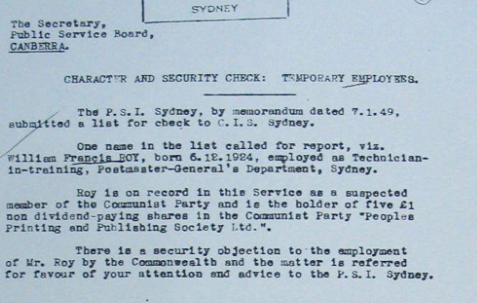
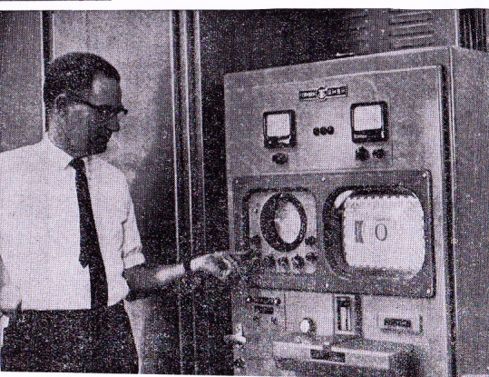
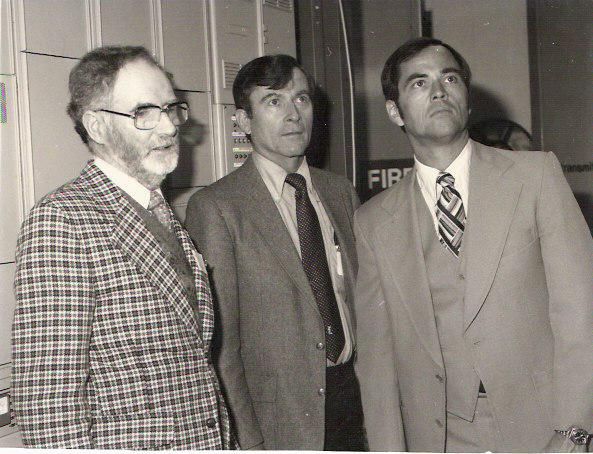




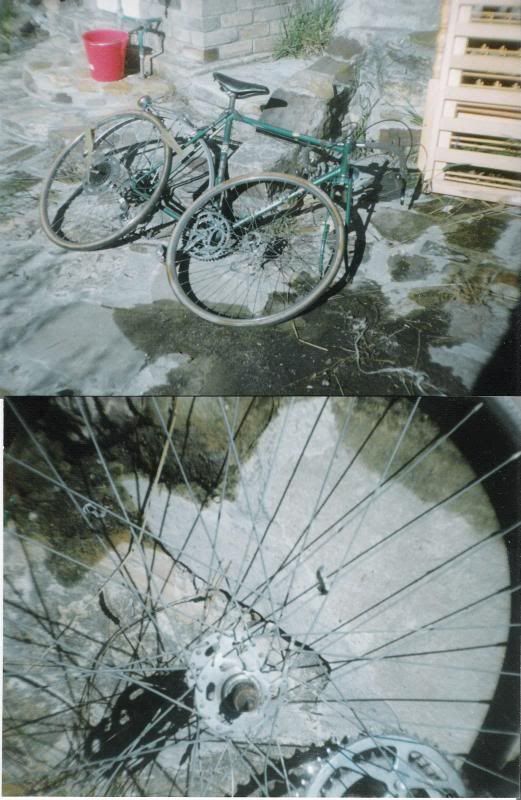

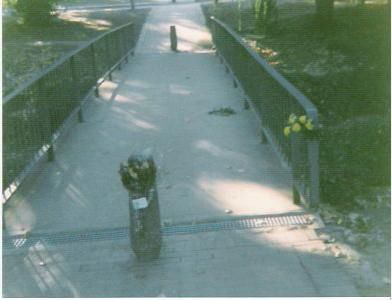









Comments
Re: Before Edward Snowden and Wikileaks, William Roy ...
You can read more here - http://williamfrancisroy.blogspot.com.au/